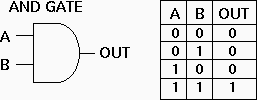The Story of 256
Why 256? Why is this number so important?
Gasp! You mean you don't know all of the details about that device which you are staring blindly into? I mean, you are looking at a computer monitor right now. I guess I shouldn't be surprised. I am a nerd and have been living and breathing computers ever since 10th grade back in 1981. It's hard for me to see what I take for granted. So, in the interest of education and to satisfy my need to babble, I present the following mini-essay on the merits of 256. May it live for ever...
The Magic #2
2 is a very magic number to most computer geeks. All signals inside a computer have two (and only two) different therefore binary values: 0 and 1. They can be thought of as off (0) and on (1) or false (0) and true (1). In computer terminology, one piece of information which can store either 0 or 1 is called a bit.
So a bit represents values from 0 to 1 (2 values). Put 2 bits together and can represent 0, 1, 2, or 3 (4 values). 3 bits can represent 0 to 7 (8 values). 4 bits means 2 to the power of 4 (2 * 2 * 2 * 2) values (16), etc.. Some number X of bits means 2 to the power of X (2 ^ X) different values can be represented.
Base 2 numbers are as important to computer geeks like myself as base 10 numbers are to other humans. Just as you know 10, 100, 1000, etc. I know 2, 4, 8, 16, 32, 64, 128, 256, 512, 1024, 2048, 4096, 8192, 16384, etc.. Yes we're a strange bunch.
AND there was light
Now that we know about the binary values in a computer, let's talk about the devices which use these values. At the heart of all binary computers is the AND-gate. This is a little electronic switch (or valve if you'd like) consists of two inputs and a single output and is usually implemented with a transistor. According to the definition, if and only if both of the inputs to an AND-gate are "on" then the output is "on". Otherwise, if either one of the inputs is "off" or if both inputs are "off" then the output is "off".

With enough numbers of this little switch combined with its friends the OR, NOT, XOR, NAND, etc. gates, you can create yourself a computer. It's certainly not that easy however the point is that the AND gate, the basic building block of a computer, takes 2 inputs to get an output. 2 is a very important number to a binary computer.
Bit Now Byte?
At some point, the early designers of the binary computer came up with the byte as the next standard unit above a bit. A byte is defined as 8-bits and can represent values from 0 to 255, or 2 to the power of 8 different values. A byte represents 256 different values.
Byte == 256
So that's it. A byte is a unit of storage in a computer which contains 8-bits and can store 256 different values: 0 to 255. Letters are usually stored in a byte for example. You have a computer with giga-bytes (1 billion bytes) of disk space and mega-bytes (1 million bytes) of memory -- well, maybe it's the future and you have giga-bytes of memory and tera-bytes (1 trillion bytes) of disk space. In any case, 256 is special since it represents the most common base unit in a computer.
Copyright 2002 Gray Watson.

